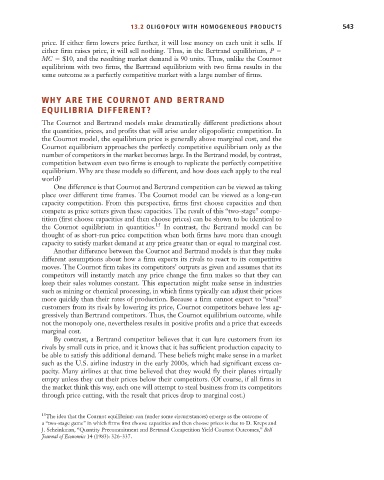Page 569 - Microeconomics, Fourth Edition
P. 569
c13marketstructureandcompetition.qxd 7/30/10 10:44 AM Page 543
13.2 OLIGOPOLY WITH HOMOGENEOUS PRODUCTS 543
price. If either firm lowers price further, it will lose money on each unit it sells. If
either firm raises price, it will sell nothing. Thus, in the Bertrand equilibrium, P
MC $10, and the resulting market demand is 90 units. Thus, unlike the Cournot
equilibrium with two firms, the Bertrand equilibrium with two firms results in the
same outcome as a perfectly competitive market with a large number of firms.
WHY ARE THE COURNOT AND BERTRAND
EQUILIBRIA DIFFERENT?
The Cournot and Bertrand models make dramatically different predictions about
the quantities, prices, and profits that will arise under oligopolistic competition. In
the Cournot model, the equilibrium price is generally above marginal cost, and the
Cournot equilibrium approaches the perfectly competitive equilibrium only as the
number of competitors in the market becomes large. In the Bertrand model, by contrast,
competition between even two firms is enough to replicate the perfectly competitive
equilibrium. Why are these models so different, and how does each apply to the real
world?
One difference is that Cournot and Bertrand competition can be viewed as taking
place over different time frames. The Cournot model can be viewed as a long-run
capacity competition. From this perspective, firms first choose capacities and then
compete as price setters given these capacities. The result of this “two-stage” compe-
tition (first choose capacities and then choose prices) can be shown to be identical to
the Cournot equilibrium in quantities. 15 In contrast, the Bertrand model can be
thought of as short-run price competition when both firms have more than enough
capacity to satisfy market demand at any price greater than or equal to marginal cost.
Another difference between the Cournot and Bertrand models is that they make
different assumptions about how a firm expects its rivals to react to its competitive
moves. The Cournot firm takes its competitors’ outputs as given and assumes that its
competitors will instantly match any price change the firm makes so that they can
keep their sales volumes constant. This expectation might make sense in industries
such as mining or chemical processing, in which firms typically can adjust their prices
more quickly than their rates of production. Because a firm cannot expect to “steal”
customers from its rivals by lowering its price, Cournot competitors behave less ag-
gressively than Bertrand competitors. Thus, the Cournot equilibrium outcome, while
not the monopoly one, nevertheless results in positive profits and a price that exceeds
marginal cost.
By contrast, a Bertrand competitor believes that it can lure customers from its
rivals by small cuts in price, and it knows that it has sufficient production capacity to
be able to satisfy this additional demand. These beliefs might make sense in a market
such as the U.S. airline industry in the early 2000s, which had significant excess ca-
pacity. Many airlines at that time believed that they would fly their planes virtually
empty unless they cut their prices below their competitors. (Of course, if all firms in
the market think this way, each one will attempt to steal business from its competitors
through price cutting, with the result that prices drop to marginal cost.)
15 The idea that the Cournot equilibrium can (under some circumstances) emerge as the outcome of
a “two-stage game” in which firms first choose capacities and then choose prices is due to D. Kreps and
J. Scheinkman, “Quantity Precommitment and Bertrand Competition Yield Cournot Outcomes,” Bell
Journal of Economics 14 (1983): 326–337.

